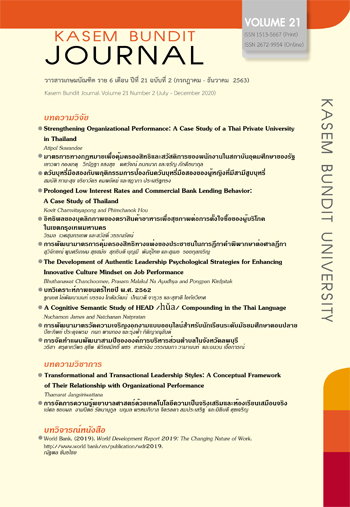การพัฒนามาตรวัดความเจริญงอกงามแบบออนไลน์สำหรับนักเรียนระดับมัธยมศึกษาตอนปลาย
Keywords:
Flourishing scale, cognitive flourishing, psychological flourishing, social flourishingAbstract
PURPOSES: This research aimed to construct a flourishing scale, to test a construct validity of the flourishing scale, and to develop an online version of the flourishing scale for upper-secondary school students. METHODS: The research procedure was divided into three stages as follows: 1) a development of the flourishing scale by synthesizing four main theories which indicated that the flourishing consisted of three components i.e. cognitive flourishing, psychological flourishing, and social flourishing; 2) a construct validity investigation by using a second-order confirmatory factor analysis via LISREL computer program among 450 participants; and 3) a development of an online version of the flourishing scale as a web application. RESULTS: The scale for measuring the flourishing for upper-secondary school students had an overall reliability coefficient of .94, for each component being .74 for cognitive flourishing subscale, .81 for psychological flourishing subscale, and .93 for social flourishing subscale respectively. The flourishing model was consistent with the empirical data in that = 1,037.56, df = 817, / df = 1.27, RMSEA = .02, SRMR = .04, GFI = .91 and CFI = .99. The factor loadings had positive values and significant at .01 level. The online version of the flourishing scale for upper-secondary school students had the highest score for appropriateness. CONCLUSIONS: The developed scale was an innovation and effectively able to measure flourishing aspects of upper-secondary school students and it is easy for use.
References
Diener, E., Wirtz, D., Tov, W., Kim-Prieto, C., Choi, D., Oishi, S., & Biswas-Diener, R. (2010). New measures of well-being: Flourishing and positive and negative feelings. Social Indicators Research, 39, 247-266.
Diener, E., Emmons, R. A., Larsen, R. J., & Griffin, S. (1985). The satisfaction with life scale. Journal of Personality Assessment, 49(1), 71-75.
Henderson, L. W., Knight, T., & Richardson, B. (2013). An exploration of the well-being benefits of hedonic and eudaimonic behaviour. The Journal of Positive Psychology, 8(4), 322–336.
Huppert, F. A., & So, T. T. C. (2013). Flourishing across Europe: Application of a new conceptual framework for defining well-being. Social Indicators Research, 110(3), 837–861.
Huta, V. & Hawley, L. (2010). Psychological Strengths and Cognitive Vulnerabilities: Are They Two Ends of the Same Continuum or Do They Have Independent Relationships with Well-being and Ill-being?. Journal of Happiness Studies, 11, 71–93.
Ishida, Saranya. (2553). A study on violence of adolescent students. Master thesis, M.Ed. (Guidance and Counseling Psychology). Bangkok:Graduate School, Srinakharinwirot University.
Keawkungwal, Sri-Ruen. (2553). Delvelopmental Psychology across life span (9th edition), Part II. Bangkok: Thammasat Printing House.
Keyes, C. L. M. (2002). The Mental Health Continuum: From languishing to flourishing in life. Journal of Health and Social Research, 43, 207–222.
Kittisuksathit, Sirinun. et al. (2555). HAPPINOMETER (1st ed.). Nakhon Pathom: Institute for Population and Social Research, Mahidol University.
Lyubomirsky, S., King, L., & Diener, E. (2005). The Benefits of Frequent Positive Affect: Does Happiness Lead to Success?. Psychological Bulletin, 131(6), 803-855.
Nuallaong, Winitra. (2555). Quality of life Predicting Factors among the First Year Medical Students. J. Psychiatr Assoc Thailand, 57(2), 225-234.
Polit, D. F., Beck, C.T. (2007). Focus on Research Methods Is the CVI an Acceptable Indicator of Content Validity? Appraisal and Recommendations. Research in Nursing & Health, 30(4), 459–467.
Pradujprom, Piyathip. et al. (2561). The development and the psychometric properties investigation of flourishing scale for undergraduate students. Journal of southern technology, 11(1), 21-29.
Preechapanich, Orraya. (2557). System Analysis and Design. Nonthaburi: IDC Premier.
Ryff, C. D., & Singer, B. (1998). The contours of positive human health. Psychological Inquiry, 9(1), 1-28.
Schumacker, R.E., & Lomax, R.G. (2016). A Beginner`s Guide to Structural Equation Modeling (4thed.). Abingdon: Routledge.
Seligman, M. E. P. (2011). Flourish: A new understanding of happiness and well-being-and how to achieve them. London: Nicholas Brealey.
Singh, D., Thakur, A., & Chaudhary, A. (2015). A comparative study between waterfall and incremental software development life cycle model. International Journal of Emerging Trends in Science and Technology, 2(4), 220–280.
Tantipiwatanasakul, Pravej. & Seetalapinan, Ekanong. (2554). Handbook for Promoting Provincial Happiness (2nd edition.). Bangkok: The Agricultural Co-operative Federation of Thailand, Ltd.
Tengtrisorn, Churit., Kunavaro, Phra Khranchit., & Vajiraporntip, Arunee. (2551). Development of Buddhist Health Measuring Instrument, Journal of Health Science, 17(Supplement VI), SV1651 – 1661.
Tirakanant, Suwimon. (2550). Scale construction for measuring variables in social science research: A practice guideline (1st edition.). Bangkok: Chulalongkorn University Printing House.
Watson, D., Clark, L. A., & Tellegen, A. (1988). Development and validation of brief measures of positive and negative affect: The PANAS Scales. Journal of Personality and Social Psychology, 54(6), 1063–1070.
Downloads
Published
How to Cite
Issue
Section
License
ทัศนคติ ความคิดเห็นใด ๆ ที่ปรากฏในวารสารเกษมบัณฑิตฉบับนี้เป็นของผู้เขียน โดยเฉพาะ มหาวิทยาลัยเกษมบัณฑิตและบรรณาธิการ ไม่จำเป็นต้องมีความเห็นพ้องด้วย







